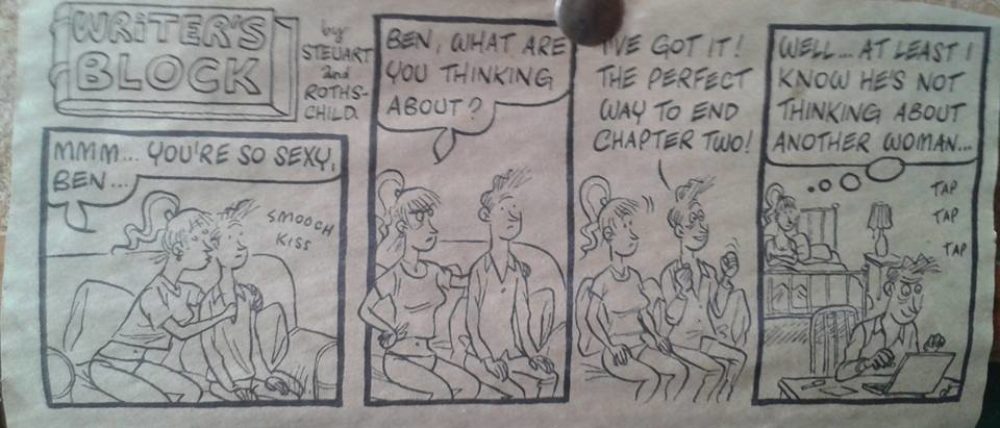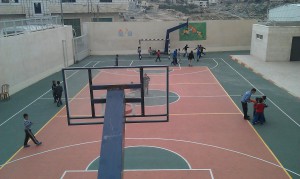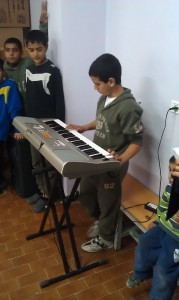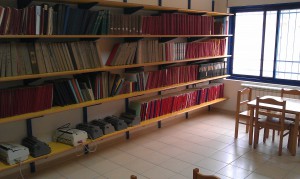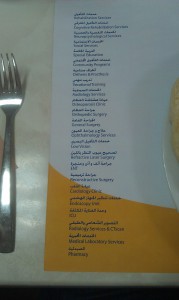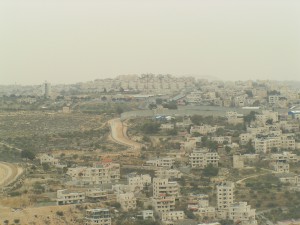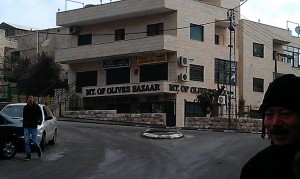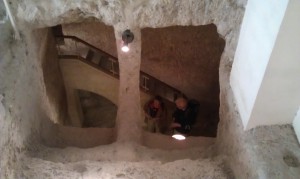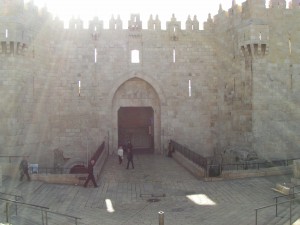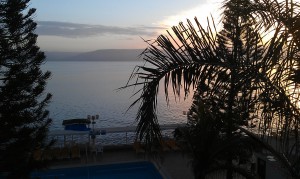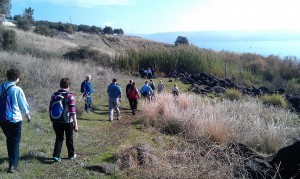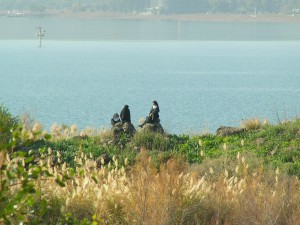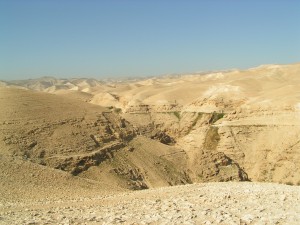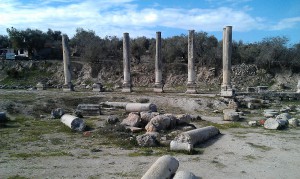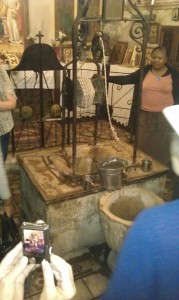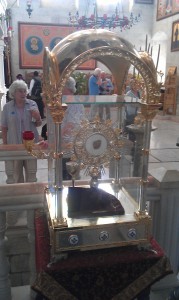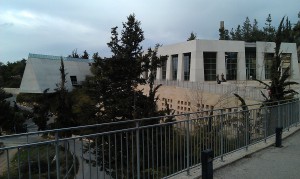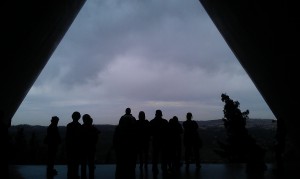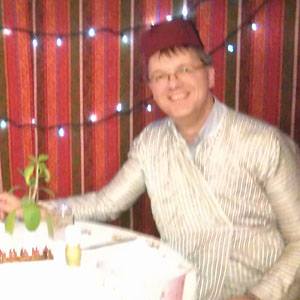As well as being all holy’n’that, there was a deeper purpose to being in Israel.
McCabe, via the McCabe Educational Trust, supports a number of charities around the world. Three are in (or should that be on?) the West Bank, so we took time to visit each one in turn to see where the money goes. All three are open to members of all communities without bias. (Which in practice of course means that most of the kids are Muslim.)
So. Jeel al Amal is a home and school for orphan and homeless boys. Now, it’s possible that if I could only understand Arabic then I would have realised the place is a Dickensian horror house of Gradgrindian awfulness, but as I could only note body language and the sounds that reached my ears then I have to assume that it really is a place of hope and substitute family for all the kids. A year ago the playground was a mass of rubble and a leaky sewer: McCabe paid for surfacing, clean-up and rerouting of the pipes. There is something about a playground full of kids running around that just sounds happy.
The boys get a chance they never would have otherwise, and seem to put their break to good use. One kid was recently accepted to study medicine at Bucharest University. Their IT guru (they also have a fully modern computer suite) is a student at Lancaster. The Chief of Police of Jericho is a Jeel boy – which proved very handy when one day a car with Jericho plates drove off with a football belonging to the school. And so on.
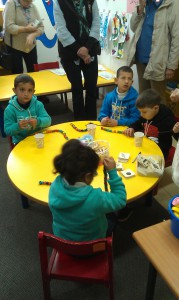 The Al-Shurooq school for blind children takes in children from the age of 3 and teaches them the basic life skills they won’t get at home – how to dress, wash, cook – as well as teaching Braille and integrating them into local schools with the support that both pupils and schools need. They too have an IT suite, with speech synthesis software, and apparently a lot of the kids are on Facebook.
The Al-Shurooq school for blind children takes in children from the age of 3 and teaches them the basic life skills they won’t get at home – how to dress, wash, cook – as well as teaching Braille and integrating them into local schools with the support that both pupils and schools need. They too have an IT suite, with speech synthesis software, and apparently a lot of the kids are on Facebook.
Half the time Al-Shurooq has to rely on local gossip and hearsay to learn of a blind child’s existence – the kids are kept hidden for the shame of it all. That’s if they’re not just rejected outright. We met a little boy who had had just that happen to him. His condition is genetic – his parents are cousins, and probably theirs were too, and theirs … Didn’t stop his father throwing him out.
Tragically, at the other end of the scale are the parents who can’t do enough for their little darlings. One mother routinely takes her kid out of school for unnecessary and painful eye surgery in Jordan, promising him he’s going to get better. He isn’t.
Either way the parents mostly don’t have a clue what to do: one little boy brought in aged 6 had only ever eaten processed baby food to minimise the mess. So, the school is also raising funds for a summer camp for parents, to teach them the realities of having a blind child.
Finally, the Bethlehem Arab Rehabilitation Society provides a range of surgical, orthotic and prosthetic services to all ages. This is by far the biggest operation, with a budget in the tens of millions. It is also a tall building, which means that from the roof you can get excellent views, not least of which is THAT WALL, that horrible concrete excrescence creeping across the landscape, inexorably slicing the communities apart the same way that it slices through their liberties.
I was never less than embarrassed going through a checkpoint into the West Bank, knowing that I was privileged to be able to enter and leave pretty well as I pleased, but going through a checkpoint in the wall beat it all. Being on a tour bus there was never a problem: once a soldier came on board, but he immediately recognised our driver as the man who used to run him to school, so they had a laugh and a chat and we were waved through. But some of our party had used public transport to get through on previous visits and had seen Palestinians have their permits torn up in front of their eyes for dissing a guard. Babies have been born in checkpoint queues because mothers couldn’t get to hospitals fast enough. It is vile and inhuman, and yes I’ve seen Yad Vashem and I DON’T CARE because that has nothing to do with this and it shouldn’t happen.
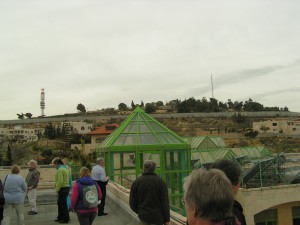
Turn around 180 degrees from the last picture – and oh look, it’s the wall again. Another couple of months and they will be encircled, and there’s not a blessed thing they can do about it.
But, having seen Yad Vashem, I have an inkling of why the Israelis will never budge.
Anyway. The charities. The centrepiece of our whole week in Israel was therefore a sponsored walk around Jerusalem. Everyone signing up was asked to commit to at least £300 of sponsorship; thanks in no small part to the generosity of our friends and congregation, we were able to raise close on £1000 between us, and the walk overall raised £40,000.
We began at Bethphage, where Jesus acquired his donkey, then over the Mount of Olives (now Oliveless, due to the Ottomans cutting them all down for their steam trains in WW1), down past Gethsemane, along the Kidron Valley and up to the south wall of the old city.
We took a coffee and toilet break at the church of St Peter in Gallicantu (roughly, “Peter at cockcrow”: the site of Jesus’s imprisonment and hence Peter’s denial. This very probably is the site, because it is close to the location of the High Priest’s house and there are prison cells carved into the bedrock below it).
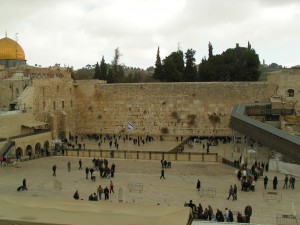
When Israel captured east Jerusalem in 1967, all this was built up … Sometimes you meet an Israeli who will admit it.
Then it was up through the Zion Gate and into the old city, through winding streets and passageways, through the Western Wall plaza, wiggle approximately along the Via Dolorosa, up over the roof of the Church of the Holy Sepulchre (seeing it at its best) and finally a slap-up lunch in the Armenian Quarter. Distance travelled as the crow flies, about a mile; distance pounded by weary feet on cobbled stones, 7 or 8 miles up and down slopes. Jerusalem is built on hills and valleys and almost nothing is level; when the Bible says “he went up” or “he went down”, he very probably did.
Being slow on the uptake, we had several times passed one of the Stations of the Cross on the Via Dolorosa before it struck me that, bloody hell, this is the original Station. Well, almost, 30 feet above it but hey.
Another long post so this is where I lay down my pen. Coming soon: the rest of the pilgrimage, including frank opinions of the Church of the Holy Sepulchre.
